Today’s discussion gave information and advice on using steady rests for different types of projects when turning. A list of vendors, video resources and books that give more information are listed after the notes for this session.
The group observed a variety of steady rest pictures from some vendor websites as well as photos of some homemade rests that were similar. Some had metal bearings and the group discussed the need to sand areas on projects due to marks left by the metal. When working on a project that would benefit from using a steady rest, it’s best to pre-plan the project and know where the rest would best reduce the vibrations in the project or give adequate support.
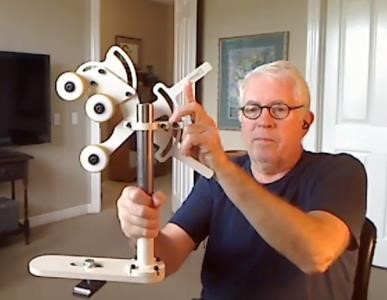
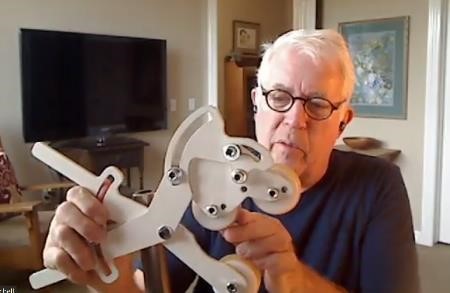
This One-Way spindle steady rest can be used with small items up to 4” in diameter. Mike Mitchell used it to support a 58” spindle he was turning. Once adjusted, he left it in that place while turning the spindle. He rough turned a place to set the steady rest, turned the areas along the spindle, and then removed the steady rest to finish turning that area. It has nylon wheels with O-rings that don’t affect the finish of the wood. This rest only works with spindles; One Way has a different unit for bowls.
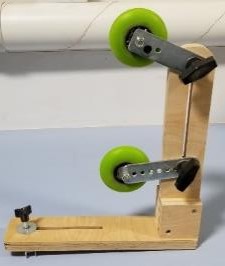
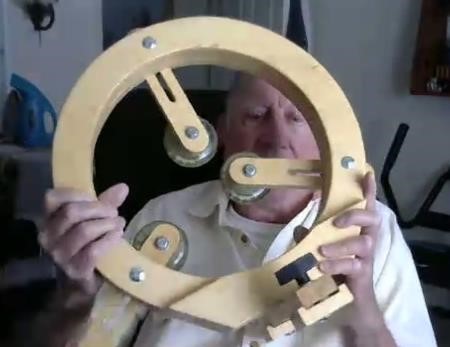
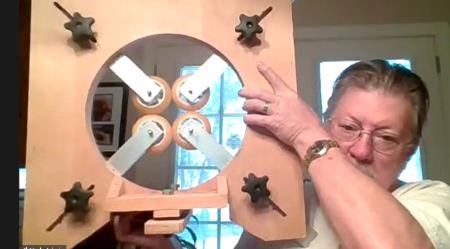
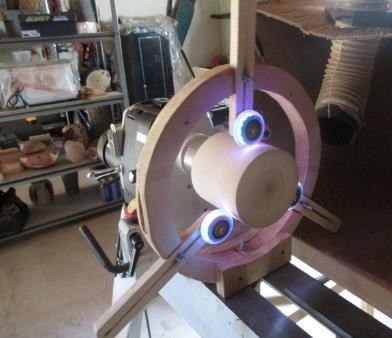
Jim Winge built his steady rest based on an AAW magazine design about 15 years ago. He used Baltic birch to construct it and the three wheels give contact all around the bowl or vase he’s supporting. It’s lathe specific because the base fits his lathe bed. He’s found that the 3 points of contact is a better design than 4 points since it’s easier to adjust for the circle shape of his project. It’s very stable.
Discussion question: When using the three points of contact on the steady rest, does it matter where the points are located on a piece? The One Way has two wheels close together at the top and a third one on the bottom. One catalog showed the One Way with the wheel direction in the opposite direction with the two wheels at the bottom. A few members have theirs at 12, 4, and 8, evenly distributed. If one is at the bottom on some lathes, it may be difficult to fit the arm between the workpiece and the lathe bed. A benefit to having two wheels on the bottom is to support the weight of the piece. The direction of forces may also make a difference. With a smaller lathe, there is less room for the arms.
One type of steady rest is tilted off center of the axis to give clearance for a laser-holding camera-holding arm on a hollowing system. (https://advancedlathetools.com/center-steadies/)
What is the purpose of a steady rest and when do you choose to use one? Generally, steady rests are used on large items such as long spindles, large platters, or bowls or long vases that extend away from the headstock. They help prevent vibration and offset the forward pressure of the tool against the project piece. They also give security to the piece so that it doesn’t fly off of the lathe. When placing the steady rest against an object, set it at a horizontal place along the wood that has less of an angle or is the flattest or widest section. Some sanding may be required after the steady rest has been removed if marks are left from the wheels.
The group looked at various steady rest plans that are described in the two reference books by Doc Green and Mike Darlow, listed at the end of the notes. These books are available for checkout from our PAW library. Each book has a variety of steady rest plans for a variety of purposes. Some examples include: a friction steady rest with a notch to hold a spindle; string steady rests to give stability, especially with very thin pieces; a pipe with plates to hold the square part of a baluster; and one instance where a 3-roller steady rest, a clothespin and a string steady rest were all used on one project. Everyone was interested in seeing Mike Darlow’s 38” long trembleur, which is a long slender, non-useful spindle that requires patience to make but no one was inspired to make one.
How often are steady rests used? One member had made his about 15 years ago and only used it around 8 times. Another member uses his 3 or 4 times a year, primarily for safety reasons with off balance pieces. Since they are used infrequently, it was suggested that members contact other members to borrow one or try one before investing in an expensive one or making one. The Carter MultiRest Work Support System (from Craft Supply) has a lot of versatility and opens up for easy removal of a project but would be a costly addition to the workshop if it’s used infrequently.
This discussion gave excellent examples of how steady rests are used. The resources listed below give more information for those interested in learning more.
Resources:
Commercial Steady Rests Are Available At:
Craft Supplies USA
Woodcraft
Rockler
Klingspor’s
Penn State Industries
Videos:
Mike Waldt, “How to Make a Steady Rest for the Wood Lathe,” YouTube,
https://www.youtube.com/watch?v=_GMXRTzMHnQ
Brian Proctor, “2 Steady Rests for the Wood Lathe, Bullet Proof, Super Strong,” YouTube,
https://www.youtube.com/watch?v=wj_R703Nkac
Alan Stratton, As Wood Turns, “Woodturning – My Steady Rest Is Still Steady,” YouTube,
https://www.youtube.com/watch?v=BBjps1xNV3s
Jim Overton, Jimson’s Stuff, “Making a Lathe Steady Rest – Lockdown Challenge,” YouTube,
https://www.youtube.com/watch?v=I94Bsj1_p_s
Reference Books (Both are available in our PAW library)
Fixtures and Chucks for Woodturning, Doc Green, Fox Chapel Publishing, 2011, pgs 130 – 143.
Woodturning Methods, Mike Darlow, The Melaleuca Press, 1999, pgs. 63 – 69, 78 – 80.
Notes written by Kathy Allen